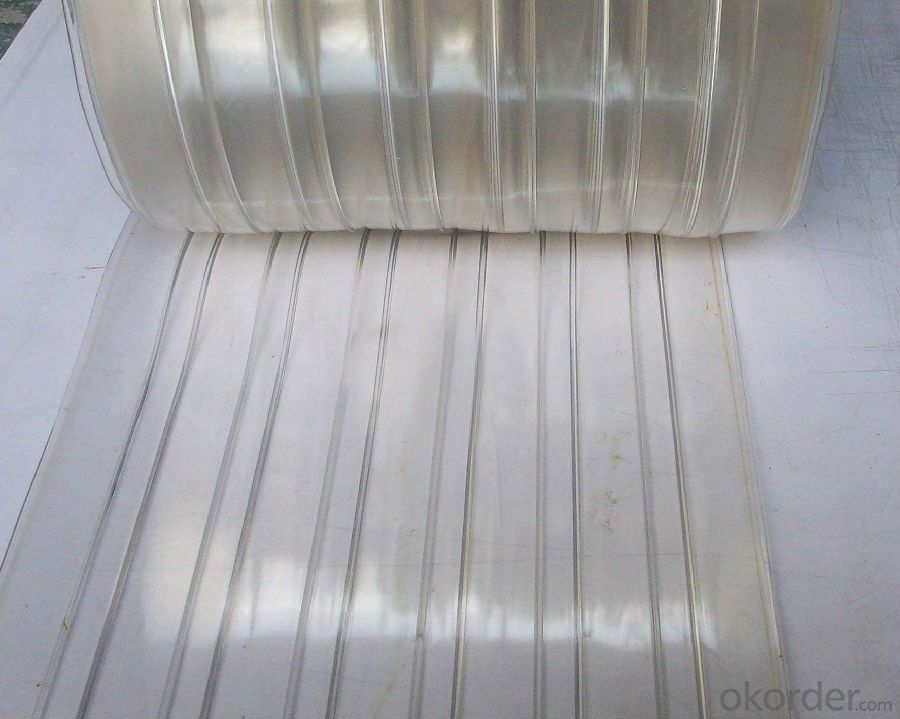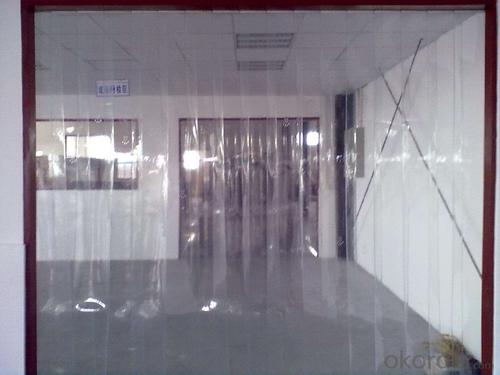antistatic transparent pvc strip curtain &clear flexible pvc soft sheet
- Loading Port:
- China main port
- Payment Terms:
- TT OR LC
- Min Order Qty:
- 1 roll
- Supply Capability:
- 10000 roll/month
OKorder Service Pledge
Quality Product, Order Online Tracking, Timely Delivery
OKorder Financial Service
Credit Rating, Credit Services, Credit Purchasing
You Might Also Like
Overview
Specifications
Material:PVC
Style:Stripe
Location:Door
Technics:Other
Use:Hospital, Hotel, Office
Width:20/30/40cm or customized
Thickness:2/3mm
Color:blue, Jade green, Dark green, yellow, nature, etc
surface resistance:10e3-10e9
Packaging & Delivery
Packaging Details:1roll/ctn, ctn size 142*17*17cm
Delivery Detail:about two weeks
product information



ABOUT US
| Business Type: | Trading Company | |
|---|---|---|
| Main Products: | wpc decking,Adhesive Tape,fiber glass,fireproofing products,Protective Film | |
| Total Annual Revenue: | Above US$100 Million | |
| Top 3 Markets: | South America 30.00% North America 20.00% Africa 15.00% |
| Location: | Beijing, China (Mainland) | |
|---|---|---|
| Total Employees: | Above 1000 People | |
| Year Established: | 2004 | |
| Certifications: | ISO9001 |
| Main Markets | Total Revenue(%) |
|---|---|
| South America | 30.00% |
| North America | 20.00% |
| Africa | 15.00% |
| Mid East | 10.00% |
| Southeast Asia | 10.00% |
| South Asia | 5.00% |
| Northern Europe | 5.00% |
| Western Europe | 5.00% |
- Q: Can I use curtains in a bathroom?
- Yes, you can use curtains in a bathroom. However, it is important to choose curtains that are made of waterproof or water-resistant material to prevent damage from moisture and humidity.
- Q: How do I hang curtains on skylights?
- To hang curtains on skylights, you can use a combination of curtain rods, brackets, and curtain rings. First, measure the width and length of your skylight to determine the appropriate size of the curtain rod. Then, install the brackets securely on either side of the skylight frame, ensuring they are level and aligned. Slide the curtain rings onto the rod and attach the rod to the brackets. Finally, hang the curtains onto the rings, adjusting them to your desired height and style.
- Q: Can I use curtains to soften the look of a room with hard surfaces?
- Certainly! Curtains are an excellent choice for enhancing the ambiance of a room that primarily consists of hard surfaces. They not only introduce an element of sophistication and elegance, but they also provide a sense of texture and contribute to a cozier and more welcoming atmosphere. By incorporating curtains, you can effectively counterbalance the rigidity and sharpness of a space with the graceful flow of fabric. Moreover, curtains possess the ability to absorb sound waves and minimize echoes, thereby creating a more comfortable and pleasing acoustic environment. If your goal is to infuse warmth and soften the aesthetics of a room characterized by hard surfaces, curtains should undoubtedly be on your list of considerations.
- Q: How do I hang curtains on a loft bed?
- When it comes to hanging curtains on a loft bed, there are various options available to you based on the design and structure of your loft bed. Here are a few methods that you can contemplate: 1. Opt for a tension rod: This is a convenient and straightforward choice. Start by measuring the width of your loft bed and then purchase a tension rod that can fit within that space. Install the tension rod at the desired height, either between the loft bed posts or any other suitable support. Once the rod is securely in place, hang your curtains directly onto it, making adjustments to achieve the desired length. 2. Install curtain hooks: If your loft bed has railings or posts with gaps, you can make use of curtain hooks or rings to hang your curtains. Attach the hooks to the railings or posts, ensuring that they are evenly spaced. Slide the curtains onto the hooks, adjusting them to your preferred length. 3. Utilize adhesive hooks: In case your loft bed has a sturdy frame or if you'd rather not drill holes, adhesive hooks can serve as an excellent option. Choose hooks that are specifically designed for holding curtains and follow the installation instructions provided by the manufacturer. Stick the hooks onto the desired spots on the loft bed frame, ensuring that they are firmly secured. Then, hang the curtains on the hooks, making any necessary adjustments. 4. Create your own DIY curtain rod: If you're feeling creative, you can craft your own curtain rod using materials such as PVC pipes, dowels, or even robust tree branches. Begin by measuring the width of your loft bed and cut the rod to the desired length. Attach hooks or brackets to the loft bed frame and insert the rod through them. Hang your curtains on the rod, adjusting them as desired. Remember to take into account the weight of your curtains and select suitable hanging methods that guarantee stability and safety. Additionally, ensure that the curtains are properly secured to prevent them from falling or becoming tangled while you're using the loft bed.
- Q: What are the best curtains for a Moroccan-inspired room?
- To capture the essence of Moroccan culture and design in a Moroccan-inspired room, it is best to choose curtains that embody these characteristics. Opt for rich and luxurious fabrics like silk, velvet, or brocade to add a touch of luxury and reflect the opulence and intricate detailing found in traditional Moroccan decor. When it comes to colors, vibrant and bold hues are often seen in Moroccan-inspired rooms. Consider selecting curtains in jewel tones such as deep blues, rich purples, or warm oranges. These colors will create a vibrant and exotic atmosphere that is typical of Moroccan design. In terms of patterns, Moroccan decor often incorporates intricate geometric shapes and motifs. Look for curtains with traditional Moroccan patterns like intricate trellis or lattice designs, arabesque motifs, or bold geometric prints. These patterns will add depth and visual interest to the room while staying true to the Moroccan aesthetic. To further enhance the Moroccan-inspired look, consider incorporating cultural elements into the curtains. Metallic accents like gold or silver embroidery, tassels, or beaded trims are commonly found in Moroccan decor. By adding these small details to the curtains, they will stand out and enhance the overall Moroccan-inspired look. Ultimately, the best curtains for a Moroccan-inspired room are those that reflect the rich colors, luxurious fabrics, intricate patterns, and cultural elements that are characteristic of Moroccan design. By selecting curtains that embody these elements, you can create an authentic and beautiful Moroccan-inspired space.
- Q: How do I choose the right curtain color for a specific room?
- When choosing the right curtain color for a specific room, there are a few factors to consider. Firstly, you should take into account the overall color scheme and style of the room. The curtain color should complement or enhance the existing colors in the space. If the room has neutral or muted colors, you have the opportunity to add a pop of color with the curtains. You can choose a bold and vibrant color that complements the room's palette, creating a focal point and adding visual interest. On the other hand, if the room already has a lot of color or patterns, it might be better to opt for curtains in a more neutral or subtle tone to maintain balance and harmony. Additionally, consider the amount of natural light the room receives. If the room is naturally well-lit, you can choose curtains in lighter colors or even sheer fabrics to allow more light to filter through. However, if the room is darker or lacks natural light, choosing curtains in a lighter color can help brighten up the space. Furthermore, think about the mood or ambiance you want to create in the room. Different colors evoke different emotions and can set the tone for the space. For example, cool colors like blues and greens can create a calming and relaxing atmosphere, while warm colors like reds and yellows can add warmth and energy to the room. Lastly, it's always a good idea to bring home samples of curtain fabrics and hang them in the room to see how they look in different lighting conditions. This will allow you to visualize how the color will interact with the room's elements and make an informed decision. Overall, choosing the right curtain color for a specific room involves considering the existing color scheme, natural light, desired mood, and personal preferences. By taking these factors into account, you can select curtains that enhance the overall aesthetic and create a cohesive and visually pleasing space.
- Q: How do I hang curtains on a canopy bed?
- To hang curtains on a canopy bed, you will need to follow these steps: 1. Start by measuring the height and width of your canopy bed to determine the appropriate length and number of curtain panels needed. 2. Purchase curtain panels that match your desired style and measurements. Make sure they come with a rod pocket or tabs for easy hanging. 3. Install curtain rods on the ceiling above the bed, ensuring they are secure and level. Use a stud finder if necessary to locate the ceiling joists for added stability. 4. Slide the curtain panels onto the rods and adjust them to your desired position. You can choose to have the curtains fully enclose the bed or leave some spaces open. 5. Once the curtains are in place, adjust them for the desired fullness and drape. Use curtain hooks or clips to create pleats or gather the fabric for a more tailored look. 6. Lastly, step back and ensure the curtains hang evenly and add the desired aesthetic to your canopy bed. By following these steps, you can easily hang curtains on your canopy bed and create a cozy and stylish space.
- Q: Are there curtains available for small basement windows?
- Yes, there are curtains available for small basement windows.
- Q: How do I choose the right curtain color for a room with light-colored walls?
- Enhancing the overall aesthetic and ambiance of a room with light-colored walls can be achieved by choosing the right curtain color. Here are some helpful tips to assist you in making the correct choice: 1. Reflect on the room's theme and purpose: Begin by determining the room's theme and purpose. Is it a living room, bedroom, or study? Are you aiming for a cozy, vibrant, or elegant atmosphere? Understanding the room's purpose will guide your color selection. 2. Complement or contrast: Decide whether you want the curtains to complement or contrast with the light-colored walls. Complementary colors create harmony by choosing shades that are adjacent or near the wall color on the color wheel. On the other hand, contrasting colors create a bold and eye-catching effect by selecting hues that are opposite or far from the wall color on the color wheel. 3. Consider the mood: Different colors evoke various moods. For a serene and calming atmosphere, opt for soft and neutral colors such as pastels, whites, or light grays. If you desire to add warmth and coziness to the room, consider earthy tones like beige, taupe, or warm browns. Vibrant and bold colors like deep blues, rich greens, or vibrant reds can create a lively and energetic feel. 4. Lighting conditions: Take into account the natural lighting conditions in the room. If the room receives ample natural light, lighter curtains can maximize brightness and create an airy space. Conversely, if the room lacks natural light, darker curtains can add depth and establish a more intimate atmosphere. 5. Test samples: Before finalizing your decision, bring home curtain samples or swatches and observe how they appear in the room. Consider the color in various lighting conditions and at different times of the day to ensure it complements the overall decor. Remember, there are no strict rules when it comes to choosing curtain colors. Ultimately, it's crucial to trust your instincts and select a color that aligns with your personal taste and complements the existing elements in the room.
- Q: What is the standard length for curtains?
- The standard length for curtains typically ranges from 84 to 96 inches, depending on the height of the windows and the desired look.
Send your message to us
antistatic transparent pvc strip curtain &clear flexible pvc soft sheet
- Loading Port:
- China main port
- Payment Terms:
- TT OR LC
- Min Order Qty:
- 1 roll
- Supply Capability:
- 10000 roll/month
OKorder Service Pledge
Quality Product, Order Online Tracking, Timely Delivery
OKorder Financial Service
Credit Rating, Credit Services, Credit Purchasing
Similar products
Hot products
Hot Searches
Related keywords































